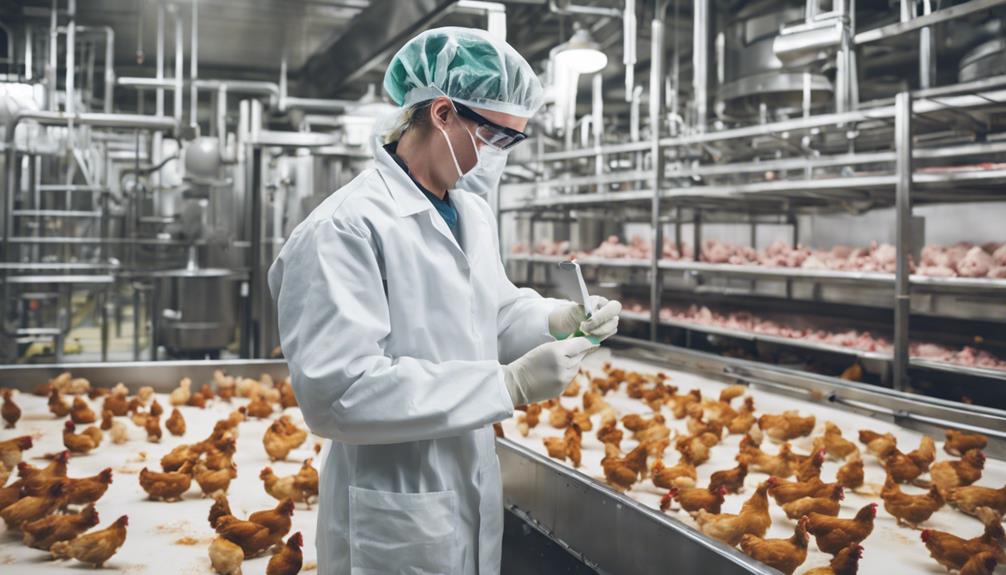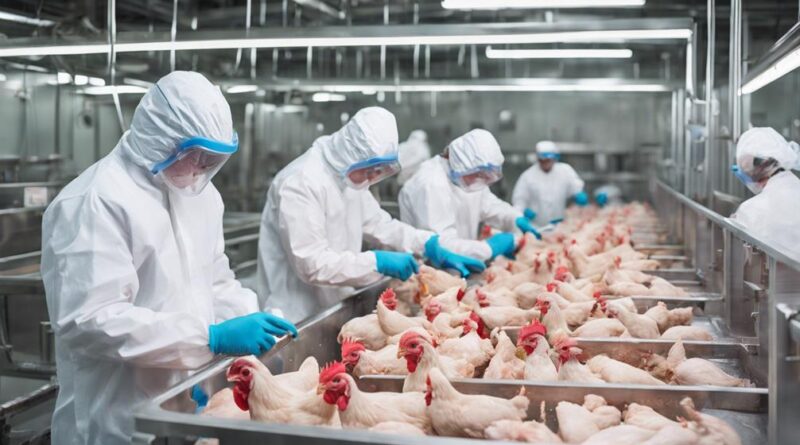Ensuring Food Safety in Chicken Slaughter and Processing"
In chicken slaughter and processing, stringent hygiene practices are vital to ensure food safety. Following hygiene protocols helps mitigate risks from pathogens like Salmonella and Campylobacter, essential for consumer health and meeting regulatory standards. Adhering to guidelines for personal hygiene, facility sanitation, and equipment cleanliness is crucial. Proper chilling, storage, and separation of raw and cooked products are necessary steps to maintain safety standards. By focusing on hygiene, you protect consumers and uphold quality. Understanding critical control points, sanitation practices, and temperature monitoring are key elements in ensuring a safe food processing environment.
Importance of Chicken Slaughter Hygiene
Maintaining stringent hygiene practices during chicken slaughter is paramount for ensuring food safety and preventing contamination. Hygiene protocols play a crucial role in the poultry processing industry by mitigating the risks associated with pathogens such as Salmonella and Campylobacter. Pathogen control is a top priority to safeguard consumer health and meet regulatory standards.
To uphold hygiene protocols, slaughterhouse staff must adhere to strict guidelines for personal hygiene, facility sanitation, and equipment cleanliness. Personnel should wear appropriate protective gear, including gloves and hairnets, to prevent cross-contamination. Regular handwashing is essential to reduce the spread of bacteria. Cleaning and sanitizing equipment and work surfaces between processing batches are necessary steps to minimize microbial growth and ensure product safety.
Furthermore, implementing pathogen control measures is imperative during chicken slaughter. Proper chilling and storage of poultry carcasses at the correct temperatures inhibit bacterial growth. Separating raw and cooked products prevents the transmission of harmful pathogens. Regular testing of processing environments and products for microbial contamination is essential to identify potential risks and take corrective actions promptly.
Critical Control Points in Processing
Ensuring food safety in chicken slaughter and processing involves identifying and controlling critical control points to prevent contamination and uphold quality standards. Two key aspects in this process are pathogen control and equipment maintenance.
Pathogen control is a crucial element in chicken processing to prevent the spread of harmful bacteria. Critical control points for pathogen control include proper temperature management during processing to inhibit bacterial growth, ensuring that all surfaces and equipment are regularly sanitized to avoid cross-contamination, and implementing strict protocols for handwashing and personal hygiene among workers to prevent the spread of pathogens.
Equipment maintenance is another essential factor in ensuring food safety during chicken processing. Regular maintenance and cleaning of processing equipment are critical control points that must be strictly adhered to. This includes cleaning and sanitizing all machinery and tools used in the processing line to prevent bacterial buildup, conducting routine inspections to identify any wear and tear that could lead to contamination, and promptly repairing or replacing any faulty equipment to maintain food safety standards.
Sanitation Practices in Slaughterhouses
To uphold food safety standards in slaughterhouses, meticulous sanitation practices must be rigorously implemented and maintained. Proper equipment maintenance and cleaning procedures are essential components of ensuring a sanitary environment in the slaughterhouse. Regular maintenance checks on equipment such as knives, saws, and processing machines are crucial to prevent cross-contamination and the spread of pathogens. Additionally, implementing strict cleaning protocols for all equipment after each use is imperative to eliminate any potential bacteria or contaminants.
Employee training plays a vital role in upholding sanitation practices in slaughterhouses. Thorough training programs should be established to educate workers on the importance of maintaining a clean and hygienic workspace. Employees must be well-versed in sanitation protocols, including proper handwashing techniques, cleaning procedures, and the appropriate use of personal protective equipment. Regular reinforcement of these protocols through routine training sessions and evaluations is key to ensuring that all staff members adhere to the highest standards of cleanliness.
Monitoring Temperature for Safety
Temperature monitoring is critical for ensuring the safety of chicken products throughout the slaughtering and processing stages. Maintaining proper temperatures is essential to prevent bacterial growth and the potential contamination of chicken products. Safety protocols dictate that chicken must be kept at specific temperatures to minimize the risk of foodborne illnesses.
During slaughter, it's crucial to monitor the temperature of the chicken carcasses to ensure they're rapidly cooled to below 40°F (4°C). This rapid cooling process inhibits the growth of harmful bacteria such as Salmonella and Campylobacter. Additionally, monitoring the temperature of the chilling water is vital to guarantee that it remains at the appropriate temperature to effectively cool the chicken.
In processing facilities, temperature monitoring continues to play a significant role. Ensuring that chicken is cooked to the correct internal temperature is essential for eliminating pathogens. Thermometers are used to verify that chicken reaches a safe temperature of 165°F (74°C) throughout.
Regular calibration of temperature monitoring equipment is imperative to maintain accuracy. Any deviations from the specified temperature ranges must be addressed promptly to prevent compromising the safety of chicken products. By strictly adhering to temperature monitoring protocols, the risk of foodborne illnesses associated with chicken consumption can be significantly reduced.
Preventing Cross-Contamination Risks
In maintaining food safety standards during chicken slaughter and processing, vigilant measures must be implemented to prevent risks of cross-contamination. Cross contamination prevention is crucial to ensuring the safety of the chicken products. To achieve this, thorough risk assessment is essential to identify potential contamination sources in the processing environment. Understanding where these risks originate from allows for targeted preventive strategies.
Training methods play a significant role in preventing cross-contamination. Proper training ensures that all staff members are aware of the risks and understand the necessary precautions to take. This includes educating employees on the importance of maintaining separate work areas for raw and cooked products, using dedicated utensils, and following strict hygiene practices to minimize the transfer of harmful pathogens.
Implementing strict protocols for cleaning and sanitizing equipment and work surfaces is also vital in preventing cross-contamination. Regular cleaning schedules, using appropriate disinfectants, and ensuring that cleaning procedures are followed diligently can significantly reduce the risk of contamination.
Furthermore, establishing clear procedures for handling and storing raw chicken, as well as implementing effective waste disposal methods, are important steps in preventing cross-contamination risks. By addressing these key areas and continuously monitoring and reinforcing these practices, the likelihood of cross-contamination can be minimized, ensuring the safety and quality of the final chicken products.
Quality Assurance Measures in Processing
Quality assurance measures play a critical role in maintaining the safety and quality standards of chicken processing operations. Ensuring proper equipment maintenance is essential to prevent malfunctions that could compromise food safety. Regular inspections and servicing of processing equipment such as slicers, grinders, and packaging machinery are crucial in preventing contamination and ensuring the efficiency of the production line. By adhering to a strict maintenance schedule, you can minimize the risk of equipment failures that may lead to product defects or safety hazards.
Employee training is another key aspect of quality assurance in chicken processing. Proper training programs ensure that all staff members understand and adhere to safety protocols, hygiene practices, and quality standards. Training should cover topics such as proper handling of poultry, sanitation procedures, and contamination prevention. By investing in comprehensive training for your employees, you can create a knowledgeable workforce that's equipped to maintain high levels of food safety throughout the processing operation.
Implementing Hazard Analysis

To effectively enhance food safety measures in chicken processing, a comprehensive hazard analysis must be diligently implemented. Hazard analysis involves identifying potential risks in the processing of chicken and developing control measures to mitigate these risks effectively.
Here's a concise guide on how to implement hazard analysis in chicken processing:
- Risk Assessment:
- Begin by conducting a thorough risk assessment of the entire chicken processing operation. Identify potential hazards such as biological, chemical, or physical contaminants that could compromise food safety.
- Utilize tools like HACCP (Hazard Analysis and Critical Control Points) to systematically assess and prioritize risks based on their severity and likelihood of occurrence.
- Involve key stakeholders in the risk assessment process to ensure a comprehensive understanding of all potential hazards that may arise during chicken slaughter and processing.
- Control Measures:
- Once hazards are identified, develop stringent control measures to prevent, eliminate, or reduce these risks to acceptable levels.
- Implement monitoring procedures to ensure that control measures are consistently applied throughout the processing stages.
- Regularly review and update control measures in response to new potential hazards or changes in processing methods to maintain effective risk management.
Role of Proper Packaging and Storage
After completing the hazard analysis in chicken processing, the focus shifts to ensuring the proper packaging and storage methods to maintain food safety standards. Packaging preservation and storage techniques play a crucial role in extending the shelf life of chicken products while ensuring food safety.
Proper packaging is essential to prevent contamination and spoilage. Vacuum sealing, modified atmosphere packaging, and airtight containers help maintain the freshness of chicken products by reducing exposure to oxygen, which can cause oxidation and bacterial growth. Additionally, using packaging materials approved for food contact ensures that no harmful chemicals leach into the chicken during storage.
When it comes to storage techniques, maintaining the right temperature is paramount. Refrigeration at temperatures below 40°F (4°C) slows down bacterial growth, preserving the quality of the chicken. Freezing at 0°F (-18°C) or below extends the shelf life even further, preventing microbial spoilage.
Labeling packages with the production date and recommended storage conditions is crucial for both producers and consumers. Following storage guidelines ensures that chicken products remain safe to consume and of high quality. By adhering to proper packaging and storage practices, you play a vital role in maintaining food safety standards and ensuring the longevity of chicken products.
Frequently Asked Questions
How Do Slaughterhouses Ensure Humane Treatment of Chickens?
To ensure humane treatment of chickens in slaughterhouses, focus on animal welfare by implementing strict guidelines.
Ethical treatment of chickens involves minimizing stress during handling, stunning methods that are quick and effective, and ensuring proper living conditions before processing.
What Are the Regulations for Waste Disposal in Processing Plants?
When it comes to waste management in processing plants, regulations play a crucial role in minimizing environmental impact. Proper disposal methods must be followed to ensure compliance with these rules.
Effective waste management systems not only maintain cleanliness but also mitigate potential harm to the environment. Adherence to waste disposal regulations is essential for processing plants to operate responsibly and sustainably.
Are There Any Concerns About Antibiotic Use in Chicken Production?
When it comes to antibiotic use in chicken production, there's growing concern about antibiotic resistance and its implications for public health.
Consumer awareness plays a crucial role in advocating for responsible antibiotic usage in poultry farming.
It's essential to understand the potential risks associated with antibiotic overuse in chicken production and to strive for more sustainable and safe practices to ensure food safety for all.
How Are Employees Trained to Handle Food Safely During Processing?
When working in chicken processing, employees undergo thorough training to handle food safely. They're taught cross-contamination prevention by keeping raw and cooked products separate.
Personal hygiene practices like frequent hand washing and wearing protective gear are emphasized to maintain cleanliness.
What Measures Are in Place to Prevent Food Fraud in Chicken Products?
When it comes to preventing food fraud in chicken products, the supply chain plays a crucial role. Proper traceability and labeling are essential measures in place.
By closely monitoring the supply chain from farm to table, companies can ensure that the chicken products are authentic and meet quality standards.
Implementing strict labeling requirements and utilizing technology for traceability are key steps to safeguard against food fraud in the chicken industry.
Conclusion
You must prioritize hygiene in chicken slaughter and processing to ensure food safety. Focus on critical control points, sanitation practices, temperature monitoring, and preventing cross-contamination risks.
Quality assurance measures and hazard analysis are essential for maintaining high standards. Proper packaging and storage play a crucial role in preserving the safety and quality of the chicken products.
Stay vigilant and implement these practices consistently to protect consumer health.
